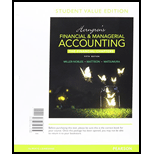
Horngren's Financial & Managerial Accounting, The Financial Chapters (Book & Access Card)
5th Edition
ISBN: 9780134078939
Author: Tracie L. Miller-Nobles, Brenda L. Mattison, Ella Mae Matsumura
Publisher: PEARSON
expand_more
expand_more
format_list_bulleted
Concept explainers
Textbook Question
Chapter 13, Problem 13.2SE
Journalizing issuance of stock- at par and at a premium
Coastal Corporation has two classes of stock: common, $4 par value; and preferred, $5 par value.
Requirements
- 1. Journalize Coastal’s issuance of 5,500 shares of common stock for $10 per share.
- 2. Journalize Coastal's issuance of 5,500 shares of
preferred stock for a total of $27,500.
Expert Solution & Answer
Want to see the full answer?
Check out a sample textbook solution
Students have asked these similar questions
?????
none
Ans plz
Chapter 13 Solutions
Horngren's Financial & Managerial Accounting, The Financial Chapters (Book & Access Card)
Ch. 13 - Prob. 1QCCh. 13 - Prob. 2QCCh. 13 - Suppose Value Home and Garden Imports issued...Ch. 13 - Prob. 4QCCh. 13 - Prob. 5QCCh. 13 - Assume that a company paid 6 per share to purchase...Ch. 13 - Prob. 7QCCh. 13 - A small stock dividend a. decreases common stock....Ch. 13 - Jackson Health Foods has 8,000 shares of 2 par...Ch. 13 - Prob. 10QC
Ch. 13 - Prob. 1RQCh. 13 - Prob. 2RQCh. 13 - How does authorized stock differ from outstanding...Ch. 13 - What are the four basic rights of stockholders?Ch. 13 - How does preferred stock differ from common stock?Ch. 13 - Prob. 6RQCh. 13 - What are the two basic sources of stockholders'...Ch. 13 - Prob. 8RQCh. 13 - If stock is issued for assets other than cash,...Ch. 13 - Prob. 10RQCh. 13 - Where and how is treasury stock reported on the...Ch. 13 - What is the effect on the accounting equation when...Ch. 13 - What are the three relevant dates involving cash...Ch. 13 - How does cumulative preferred stock differ from...Ch. 13 - What is a stock dividend?Ch. 13 - Prob. 16RQCh. 13 - What are some reasons corporations issue stock...Ch. 13 - Prob. 18RQCh. 13 - What does the statement of retained earnings...Ch. 13 - What is a prior-period adjustment?Ch. 13 - Prob. 21RQCh. 13 - What does earnings per share report, and how is it...Ch. 13 - What is the price/earnings ratio, and how is it...Ch. 13 - What does the rate of return on common stock show,...Ch. 13 - Prob. 13.1SECh. 13 - Journalizing issuance of stock- at par and at a...Ch. 13 - Journalizing issuance of stock-no-par Ashford...Ch. 13 - Journalizing issuance of stock- stated value...Ch. 13 - Journalizing issuance o f stock for assets other...Ch. 13 - Prob. 13.6SECh. 13 - Accounting for cash dividends Frenchroast Company...Ch. 13 - Dividing cash dividends between preferred and...Ch. 13 - Prob. 13.9SECh. 13 - Prob. 13.10SECh. 13 - Prob. 13.11SECh. 13 - Preparing a statement of retained earnings Tinder,...Ch. 13 - Analyzing the effect of prior-period adjustments...Ch. 13 - Prob. 13.14SECh. 13 - Prob. 13.15SECh. 13 - Prob. 13.16SECh. 13 - Prob. 13.17ECh. 13 - Prob. 13.18ECh. 13 - Journaling issuance of stock Skylar Systems...Ch. 13 - Prob. 13.20ECh. 13 - Prob. 13.21ECh. 13 - Prob. 13.22ECh. 13 - Journalizing treasury stock transactions and...Ch. 13 - Journalizing issuance of s tock and treasury stock...Ch. 13 - Computing dividends on preferred and common stock...Ch. 13 - Computing dividends on preferred and common stock...Ch. 13 - Journalizing a stock dividend and reporting...Ch. 13 - Prob. 13.28ECh. 13 - Reporting stockholders' equity after a stock split...Ch. 13 - Determining the effects of cash dividends, stock...Ch. 13 - Prob. 13.31ECh. 13 - Prob. 13.32ECh. 13 - Computing earnings per share and price/earnings...Ch. 13 - Computing rate of return on common stockholders'...Ch. 13 - Organizing a corporation and issuing stock John...Ch. 13 - Identifying sources of equity, stock issuance, and...Ch. 13 - Prob. 13.37APCh. 13 - Journalizing dividends and treasury stock...Ch. 13 - Journalizing dividend and treasury stock...Ch. 13 - Prob. 13.40APCh. 13 - Prob. 13.41BPCh. 13 - Prob. 13.42BPCh. 13 - Prob. 13.43BPCh. 13 - Journalizing dividends and treasury stock...Ch. 13 - Journalizing dividend and treasury stock...Ch. 13 - Prob. 13.46BPCh. 13 - Sources of equity and journalizing stock issuance...Ch. 13 - Prob. 13.1CTFSCCh. 13 - Prob. 13.1CTCA
Knowledge Booster
Learn more about
Need a deep-dive on the concept behind this application? Look no further. Learn more about this topic, accounting and related others by exploring similar questions and additional content below.Similar questions
arrow_back_ios
SEE MORE QUESTIONS
arrow_forward_ios
Recommended textbooks for you
 Accounting (Text Only)AccountingISBN:9781285743615Author:Carl Warren, James M. Reeve, Jonathan DuchacPublisher:Cengage Learning
Accounting (Text Only)AccountingISBN:9781285743615Author:Carl Warren, James M. Reeve, Jonathan DuchacPublisher:Cengage Learning Corporate Financial AccountingAccountingISBN:9781305653535Author:Carl Warren, James M. Reeve, Jonathan DuchacPublisher:Cengage Learning
Corporate Financial AccountingAccountingISBN:9781305653535Author:Carl Warren, James M. Reeve, Jonathan DuchacPublisher:Cengage Learning Intermediate Accounting: Reporting And AnalysisAccountingISBN:9781337788281Author:James M. Wahlen, Jefferson P. Jones, Donald PagachPublisher:Cengage Learning
Intermediate Accounting: Reporting And AnalysisAccountingISBN:9781337788281Author:James M. Wahlen, Jefferson P. Jones, Donald PagachPublisher:Cengage Learning College Accounting, Chapters 1-27 (New in Account...AccountingISBN:9781305666160Author:James A. Heintz, Robert W. ParryPublisher:Cengage Learning
College Accounting, Chapters 1-27 (New in Account...AccountingISBN:9781305666160Author:James A. Heintz, Robert W. ParryPublisher:Cengage Learning College Accounting, Chapters 1-27AccountingISBN:9781337794756Author:HEINTZ, James A.Publisher:Cengage Learning,
College Accounting, Chapters 1-27AccountingISBN:9781337794756Author:HEINTZ, James A.Publisher:Cengage Learning,

Accounting (Text Only)
Accounting
ISBN:9781285743615
Author:Carl Warren, James M. Reeve, Jonathan Duchac
Publisher:Cengage Learning

Corporate Financial Accounting
Accounting
ISBN:9781305653535
Author:Carl Warren, James M. Reeve, Jonathan Duchac
Publisher:Cengage Learning

Intermediate Accounting: Reporting And Analysis
Accounting
ISBN:9781337788281
Author:James M. Wahlen, Jefferson P. Jones, Donald Pagach
Publisher:Cengage Learning


College Accounting, Chapters 1-27 (New in Account...
Accounting
ISBN:9781305666160
Author:James A. Heintz, Robert W. Parry
Publisher:Cengage Learning

College Accounting, Chapters 1-27
Accounting
ISBN:9781337794756
Author:HEINTZ, James A.
Publisher:Cengage Learning,
Stockholders Equity: How to Calculate?; Author: Accounting University;https://www.youtube.com/watch?v=2jZk1T5GIlw;License: Standard Youtube License